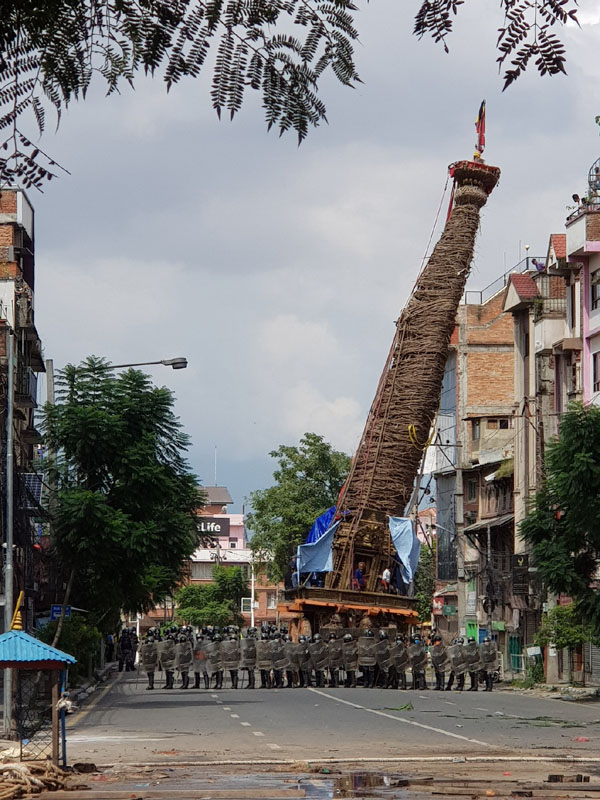Lockdown of cultural heritage
Indra Jatra, one of the most vibrant festivals in Kathmandu, was cancelled this year due to the COVID-19 pandemic. The only trace of this festival was the high platform raised at Naradevi, with the statue of Lord Indra facing west, with his arms stretched to either side, palms facing up and sitting in a lotus position. Next to this was a wooden frame with oil lamps. The platforms at Kilagal, Wangha (Indrachowk), Nasal Chowk (inside the Hanuman Dhoka Palace), Maru (southeast of Kasthamandap), Jyabahal and Musumbahal were not erected. Rituals would have been carried out by the Buddhist Bajracharya and Hindu Rajupadhyaya priests.
The Yoshi, the tall pole with Indra’s banner, the Indradhvaja, was not raised this year. It would have been brought from a special forest near Nala, on the western outskirts of the Kathmandu Valley, dragged to Hanuman Dhoka, where it would have been raised with great pomp. This year, there were only the women selling plastic bowls of grain to be fed to the pigeons, scurrying away whenever the municipal guards strolled by.
The chariots of Kumari, Ganesh and Bhairav were not pulled around the city, and the head of state did not get the blessing of the Living Goddess, Kumari. Tradition has it that the king could only rule if he was blessed by her on this day. In 1768 CE, the Kumari festival was held even though the city was besieged by the Gorkha army and the conquering King Prithvi Narayan Shah entered the city in time to sit down on the throne to get Goddess Kumari’s blessing. Due to the pandemic, instead of visiting the Living Goddess, President Bidya Devi Bhandari carried out atonement rituals at her office in Shital Niwas.
Many festivals since March have been curtailed, particularly the community-related activities. The Rato Machhendranath chariot festival was postponed since April, however, was erected in Patan, and the deity was installed at the end of July, but then sat idle. The traditional belief is that if the chariot festival is not concluded by Phulpati, the beginning of the Dasain festival, responsibility for the deity would be transferred to the members of the Akhan Baha, the Akhandasila Mahavihar, in Bhaktapur. It was possible that due to the threat of losing their deity, Bungadyo, there was pressure to perform the rituals in time. The cancellation of all the big festivals in Bhaktapur and Kathmandu, such as what happened with Indra Jatra recently, would have aroused concern within the community in Patan.
On Thursday, September 3, while the stakeholders responsible for pulling the Rato Machhendranath chariot were preparing to meet, to discuss how to proceed with the festival, the chariot was commandeered by a group of enthusiasts. Initially, the small group couldn’t move the chariot, but slowly the bystanders got drawn in, and despite the pandemic lockdown, the crowd grew quickly. Proper rituals had not been performed, and the overhead cables along the chariot’s path had not been cut. The chariot had not been fully constructed and was tilting heavily to the right, nearly toppling over as it was pulled onto the road.
Armed police were brought in, and they dispersed the crowds and captured the chariot within fifteen minutes, efficiently and professionally. Plans were hastily made to complete the required rituals within a few days, carrying the Bungadyo statue around the city in a khat, a palanquin, under curfew if required.
There have been numerous pandemics in the past, recorded in the chronicles as early as the beginning of the second century CE, during the rule of Pashuprekhadeva. Despite such pandemics, many festivals originating many centuries ago are still alive. These festivals are resilient, adapted to the changing circumstances, and will be continued by generations to come.
kai.weise@yahoo.com






